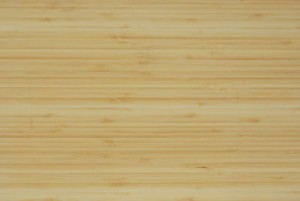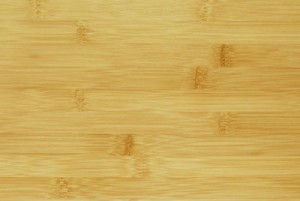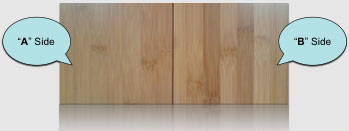We are asked many questions about bamboo boards and flooring, so thought to summarise the most common here…
I keep hearing terms like “CH” & “NV” and codes like that when people talk about bamboo – what does it mean?”
Each industry has it’s set of acronyms – bamboo is no exception.

Natural Bamboo with a Vertical surface construction

Carbonised Bamboo with a Horizontal surface construction
There are two primary characteristics that we typically use when forming these acronyms, the first is related to the Colour difference:
Natural & Carbonised
Natural is the natural colour of the bamboo.
Carbonising is achieved by steaming the bamboo under pressure to create a coffee coloured plank.
The second characteristic is related to the Surface Construction difference:
Horizontal & Vertical:
Horizontal is when the narrow edges of the bamboo strips are laminated together, creating a clearly visible bamboo grain effect.
Vertical is when the wide edges of the bamboo strips are laminated together creating a more busy grain effect.
Boards and laminated solid bamboo flooring planks are referred to by combining the Colour with the Surface Construction type, forming the acronym.
So for example;
NH = Natural (colour) Horizontal ( surface construction)
CV = Carbonised (colour) Vertical (surface construction)
SWC = SW – Strand Woven (construction) Carbonised (colour)
How does bamboo flooring compete with other types of flooring i.t.o. durability, colour and cost?
Durability: very durable, similar to other solid wood floors, can last a few lifetimes if well maintained. Bamboo floors can be sanded and resealed if required.
Colour: Typically it is available in two standard colours; natural – a “Beech or Maple yellow/white” & carbonised – a coffee or amber colour. However bamboo stains very evenly, so bamboo is available in any colour that it can be stained. We have even seen red stained bamboo flooring.
Cost: Installed, typically our Eco-Logic solid bamboo flooring sits at the bottom end of the hard wood floor pricing range. There are certain product lines that compete well against the higher quality laminate floor products. You can expect a price range from R 300 – R 650 per sqm installed for a bamboo floor . We encourage you compare that to other solid wood floor installed prices.
What is this “A” & “B” side I keep hearing about when referring to bamboo boards?
Unless otherwise indicated bamboo boards have an “A” side & a “B” side. The only difference is the colour matching of the strips. This is most obvious on the Horizontal Construction boards.
Remember, bamboo is a natural product, so colour variations are completely normal. The reason for the colour matching relates to personal taste and application, some require & prefer distinct colour contrasts (of a “B” side), whilst others prefer a more even grain (as per the “A” side).
When the bamboo board is unfinished, it is sometimes not immediately apparent which is the “A” side & which is the “B” side. If you know what to look for, it is readily visible. Keep in mind that waxing, oiling and other coatings typically enhance the grain, making the “A” & “B” sides distinctly different. So you need to keep this in mind when having your boards cut – to ensure you have a consistent “A” & “B” side facing the way your want.
How is strand woven bamboo made?
The bamboo culms are split into strips that are then crushed in long fibers. These fibers are soaked in glue and then pressed into blocks at a pressure of 2,500Kg.
Here is a video of the crushed bamboo strips being pressed into blocks – listen for the loud popping sound as the massive 2.5 ton press starts to reach maximum pressure.
The end result are these blocks that are then cut into planks for further processing.
What areas can bamboo flooring be used in domestic and commercial applications?
“Solid bamboo flooring” [made up of laminated bamboo strips] is generally more suited to domestic applications (bedrooms, kitchens, living room, etc). We have a number of solid bamboo installations in commercial applications (dance floors, restaurants). The wear and tear in a restaurant with the chairs and tables being dragged around can eventually result in a few indentations to the floor (these can be sanded out if required). However the dance floors have stood up extremely well. So it really comes down to the application.
“Strand woven bamboo” is ideal for both commercial and domestic use as it is very hard (hardest wood floor surface barring Brazilian Teak) and durable. We have many installations in commercial situations including hotel lobbies & restaurants. Have a look at some of the photos in our gallery.
Can I use bamboo flooring in my bathroom?
A VERY qualified “maybe”, but we do not recommend it. Here’s why; all timber absorbs the surrounding moisture. When this happens, the planks expand. It is important that the planks expand at an even rate.
The problem in a bathroom is that the water starts to pool UNDER the flooring planks. When this happens, the underside of the flooring plank absorbs that water and expands. With the bottom of the plank expanding more than the top (there’s more water at the bottom), you end up with the flooring planks cupping (the bottom is wider than the top).
This uneven movement puts a lot of stress on the joins between the planks.
Having said that, we have clients who have successfully installed bamboo flooring in a bathroom. It really comes down to how the bathroom is used. If the kids are going to be splashing in the bath, it’ll be a bad idea.
Are there various classifications of bamboo flooring when it comes to traffic?
No official standards of which we’re currently aware.
However, there are a number of standards that can be used as a benchmark to help you evaluate bamboo flooring suitability;
- Hardness (ASTM 1037) – check out the hardness comparison chart here. You’ll notice that solid bamboo is comparable to a Red Oak floor & Strand Woven Bamboo comparable to a Brazilian Teak floor. Hardness counts in that it gives you an idea of how the floor will hold up to traffic, especially traffic like high heeled shoes.
- Slip Resistance (ASTM D2047).
Is bamboo flooring a solid or laminate type product?
Consider Bamboo flooring a solid wood product. Although the solid bamboo floor is made up of “laminated” bamboo strips, the end product is a solid bamboo plank. It shares many similarities with a solid wood floor.
There are also bamboo engineered floor products with a 5 mm bamboo layer on cheaper wood substrate (typically Poplar). These engineered flooring products are more like a traditional laminate floor.
With strand woven bamboo, the bamboo fibers are compressed together to form a solid block. The flooring planks are then cut from the solid blocks to the required dimensions.
Is bamboo flooring installed in a similar manner to traditional solid or laminate flooring and if not how is it installed?
[Installers may consult our installation guidelines]
Bamboo flooring is installed using exactly the same techniques as a solid wood floor:- you can either float the floor on a slab (most common technique), or use a joisted base.
For T&G floated installations the most popular options include the Elastilon system and “glue down”.
For floated floors, we offer a range of flooring planks that use a click locking system. We also offer an option to have a factory installed underlay directly applied to the flooring planks. This completely eliminates the need to install an underlay (at additional cost) before installing the flooring planks. The resultant gain is a much quicker and more cost effective installation for floated floors.
As with all wooden flooring (or any hygroscopic flooring), installation of bamboo flooring requires the underlying slab or screen to have a moisture content of below 5%. Also, as with all timber, the bamboo planks need to be acclimatised on site for a minimum of 5 days before installation.
What are the advantages and disadvantages of installing a bamboo floor compared to similar wooden floors and other floor finishes?
- Solid Bamboo performs very similarly to Red Oak, but is significantly more stable, moisture tolerant and eco-friendly.
- Strand woven bamboo is all of the above but is much harder (hardest wooden flooring baring Brazilian Teak) and therefore highly resistant to indentation by stiletto shoe heels, piano wheels, etc.
- Our Eco-Logic bamboo commercial flooring planks are supplied with a factory pre-finish. Solid wood is normally finished on site (normally a smelly & time consuming process) at additional expense. Our flooring also includes an Aluminium Oxide hardener in the finish resulting in a very durable (against scuffing, cigarette burns & chemicals). Solid wood floors typically will not have such a hardener applied on site.
- Bamboo planks are available in standard T&G and slightly more expensive click lock options. Click lock installations can take a third of the time of a T&G installation.
- If excessive water exposure is a high possibility, then bamboo, laminates & solid wood floors are not a good choice for the floor covering.
What are the most important checks and/or tips to remember when specifying or installing a bamboo floor?
Bamboo, like solid wood is hygroscopic [absorbs and exudes moisture naturally], so acclimatisation of the bamboo planks on site is critical. Expansion gaps are essential to allow for the natural movement of the floor as it “breathes”. The moisture level of the underlying slab/screen must be below 5% BEFORE installation can begin. A high quality moisture vapour barrier correctly applied to the underlying screed is also very important. Then, wherever the bamboo floor could be exposed to water (exterior doors), it is essential that there be an adequate water seal.
Are there any regulations or by-laws regulating bamboo flooring?
None of which we are currently aware.
What floor substructure is required for the installation of a bamboo flooring?
A slab/screed for floated installations & joists for raised floors.
Does bamboo flooring fit in with a specific style of architecture or interior design and if so why?
Although bamboo is botanically classified as a grass, it is classified as a solid wood by the construction industry. Bamboo tends to be most suited to “classy / opulent / luxurious” interiors. But that is surely not a limit. We have clients that have installed bamboo floors & boards (stained) in applications where it is not even immediately apparent that the floor or product is made from bamboo. So wherever you’d specify a solid wood or laminate floor (but not limited to) is where a bamboo floor, with it’s excellent green credentials, would be ideal.
What are the current trends (both locally and internationally) when it comes to bamboo flooring?
[Check out our Blog, we have updated commentary on flooring trends]
Solid bamboo remains popular world wide, but strand woven bamboo is starting to gain significant traction as the prices have started to fall due to the Style Plaehn patient being overruled in the USA, and the Chinese patient board revoking Styles’ Chinese patient, thus allowing greater competition. Initially, to our knowledge, there were only three strand woven bamboo patient holders (each with their own unique patient). A number of other factories were producing (possibly lower quality) strand woven bamboo in contravention of the Style patent.
The factories are coming up with new products virtually monthly, some compelling and others not. There is even a manufacturer that produces a “glow in the dark” bamboo floor with a luminescence coating. Our one product range; “Rustic bamboo” & “Wide Grain bamboo”, demonstrate this trend.
What types of tools does one use to install a bamboo floor?
Same as for a solid wood floor. Just make sure you have a good motor on your saw (bamboo is hard!) and that you use hardened tip blades, as the bamboo is hard. We also recommend a 80 tooth blade.
We have some more info on this question in our installation guidelines.
Can bamboo flooring be easily maintained especially in a more commercial environment?
Absolutely! Cleaning is simple with a dry mop or vacuum cleaner. No oils, special flooring waxes, etc, are required. Just ensure dirt trapping mats are installed at all the exterior doors to reduce dust build up scratching the surface.
If you do end up with scratches (these are mostly just surface scratches, as the Aluminum Oxide coating is very hard), rubbing in some “Teak Oil” will take care of the majority of these scratches. In a worst case scenario, if the scratch penetrates into the wood (someone dragged a piano with a broken steel wheel across the floor), there are a number of techniques to repair – from sanding & re-coating to plank replacement.
Is bamboo flooring an environmental friendly product and if so why?
Yes. It’s main green credentials are because it is a sustainable and highly renewable resource. Sustainable because it only takes 5-6 years for the bamboo tree to mature vs traditional hardwoods taking anything from 12-120 years. Renewable because bamboo has a rhizome root system. This means that when one tree is harvested, it is good for the plant and a new shoot takes it’s place, no need for replanting. There are a whole bunch of other things, you can look at this page for more detail on the eco characteristics of bamboo.
What colours and patterns are available in bamboo flooring?
Bamboo stains well, so colour really comes down to choice. We offer the standard “Natural” and “Carbonised” colours as standard, stains are special order items & have a Minimum Order Quantity. With a range of available plank sizes, an installer can create all manner of patterns and designs.
